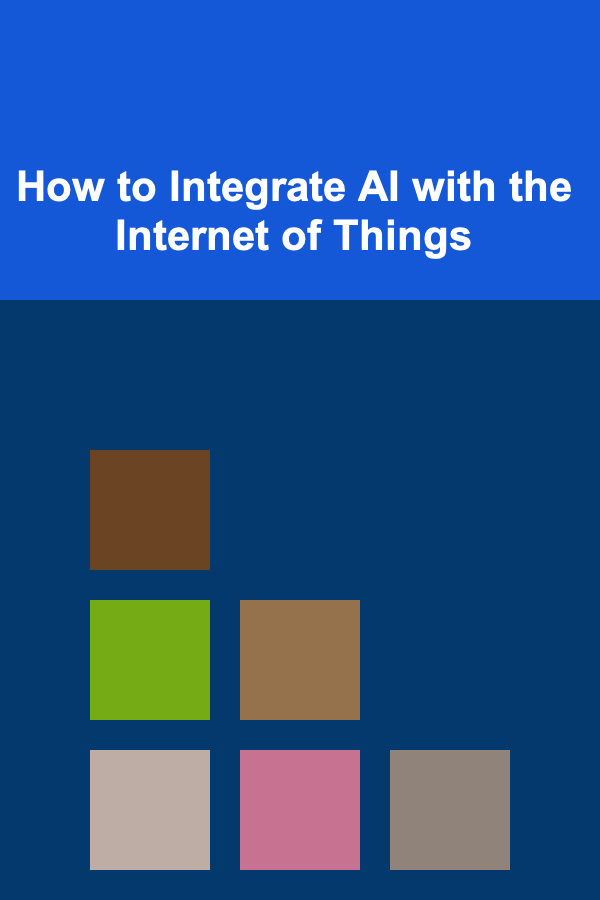
How to Integrate AI with the Internet of Things
ebook include PDF & Audio bundle (Micro Guide)
$12.99$11.99
Limited Time Offer! Order within the next:

The Internet of Things (IoT) and Artificial Intelligence (AI) are two technological trends that have garnered significant attention in recent years. Each is transformative on its own, but together, they offer the potential to create a new generation of intelligent systems that can revolutionize industries, improve efficiency, and enhance the way we live. By combining the vast network of interconnected devices offered by IoT with the advanced data analysis capabilities of AI, we can create systems that are more responsive, adaptive, and intelligent than ever before.
In this article, we will explore how AI can be integrated with IoT, the benefits of this integration, and the challenges that need to be overcome. We will also delve into practical applications, use cases, and the future of this powerful combination.
What is the Internet of Things (IoT)?
The Internet of Things (IoT) refers to a network of physical devices---ranging from everyday objects like thermostats, cars, and wearables to industrial machinery and infrastructure---that are connected to the internet. These devices are embedded with sensors, software, and other technologies to collect and exchange data with other devices or centralized systems. The core idea behind IoT is to create a world where everything is connected, allowing for smarter management and automation.
IoT can be broken down into a few key components:
- Devices/Things: These are the physical objects that collect data through sensors (e.g., temperature, humidity, motion, pressure, etc.) and can perform actions based on received information.
- Connectivity: The devices are connected to the cloud or a centralized system where the data is processed. Connectivity can happen via Wi-Fi, Bluetooth, Zigbee, 5G, or other network protocols.
- Data Processing: Once the data is collected, it needs to be processed and analyzed, often in real-time, to extract useful insights or trigger actions.
- User Interface: A dashboard or interface that presents the data and insights in a meaningful way to users, allowing them to take action or make informed decisions.
What is Artificial Intelligence (AI)?
Artificial Intelligence (AI) is the field of computer science dedicated to creating machines that can simulate human intelligence. AI enables machines to learn from experience, adapt to new information, and perform tasks that typically require human intelligence, such as speech recognition, decision-making, problem-solving, and pattern recognition.
AI can be classified into the following categories:
- Machine Learning (ML): A subset of AI that focuses on algorithms that enable systems to learn from and make predictions based on data. ML models improve over time as they process more data.
- Deep Learning: A subfield of ML that uses artificial neural networks to model complex patterns and representations in large datasets. Deep learning is particularly useful in tasks like image and speech recognition.
- Natural Language Processing (NLP): The ability of machines to understand and generate human language. NLP is used in virtual assistants, chatbots, and text analysis.
- Computer Vision: AI systems that can interpret and analyze visual information from the world, used in applications like image recognition and autonomous vehicles.
- Robotics: AI-powered robots that can perform tasks autonomously, ranging from manufacturing to healthcare.
The Synergy Between AI and IoT
The integration of AI with IoT is not just about adding intelligence to devices---it is about enabling machines to process and analyze data in real-time to make smarter decisions. IoT devices generate vast amounts of data, but this data is of little value unless it is processed and acted upon efficiently. AI can help to turn this data into actionable insights by detecting patterns, making predictions, and taking automated actions.
Why Integrate AI with IoT?
- Improved Decision Making: AI enables IoT devices to make intelligent decisions based on real-time data, improving the efficiency and effectiveness of the entire system.
- Automation and Efficiency: AI can automate the decision-making process, reducing human intervention and increasing operational efficiency.
- Predictive Capabilities: IoT devices can continuously collect data, and AI can analyze this data to predict future events or failures before they occur, reducing downtime and improving maintenance schedules.
- Enhanced User Experience: AI can interpret data from IoT devices to provide more personalized services or recommendations to users, making interactions with devices more intuitive and tailored to individual needs.
How AI Enhances IoT Systems
- Data Analysis and Insights: IoT generates huge amounts of data, and AI provides the tools to analyze this data. Machine learning algorithms can identify patterns, trends, and anomalies in real-time, enabling smarter decision-making.
- Automation of Actions: With AI integration, IoT devices can not only collect data but also take action based on that data. For example, an AI-powered smart thermostat can adjust the temperature in your home based on your preferences and patterns of behavior, automatically optimizing energy use.
- Edge Computing: Traditional IoT systems rely heavily on cloud computing, where data is sent to the cloud for processing. However, with AI and edge computing, some of the data processing is done on the device itself, reducing latency and bandwidth requirements. This is particularly important for time-sensitive applications where real-time decision-making is critical.
- Personalization: AI can enhance the personalization of IoT devices by learning user preferences over time. For instance, a smart refrigerator could suggest recipes based on what is inside and even order missing ingredients.
- Security: AI can be used to detect unusual patterns of behavior in IoT networks, helping to identify potential security breaches or unauthorized access before they escalate.
Practical Applications of AI in IoT
1. Smart Homes
The integration of AI and IoT has transformed the concept of smart homes. IoT devices like smart thermostats, security cameras, smart lights, and appliances can be controlled remotely or automated through AI algorithms. These devices can learn the habits and preferences of their users to provide greater comfort and efficiency.
- Example: A smart thermostat learns the temperature preferences of the homeowner and adjusts heating or cooling automatically based on time of day and occupancy patterns. AI can optimize energy consumption by reducing waste when the house is empty.
2. Healthcare
AI and IoT are revolutionizing healthcare through wearable devices that monitor vital signs, track fitness, and predict health conditions. IoT devices collect data such as heart rate, body temperature, blood pressure, and even glucose levels. AI models can analyze this data to provide early warnings of potential health issues and suggest preventive measures.
- Example: Wearables like smartwatches can detect abnormal heart rhythms and alert users or healthcare providers about potential heart problems before they become critical.
3. Smart Cities
In smart cities, IoT devices are used to monitor and manage various aspects of urban life, including traffic, waste management, energy consumption, and public safety. AI can optimize city operations by analyzing data from sensors to predict traffic congestion, improve waste collection schedules, and enhance law enforcement efficiency.
- Example: AI-powered traffic management systems can analyze traffic flow data in real-time to adjust traffic lights and alleviate congestion, reducing commute times and improving air quality.
4. Industrial IoT (IIoT)
In industrial settings, IoT devices collect data from machinery, equipment, and sensors to monitor performance and predict maintenance needs. AI can analyze this data to identify patterns and predict when a machine is likely to fail, enabling proactive maintenance and reducing downtime.
- Example: Predictive maintenance systems in manufacturing can alert technicians when machinery needs servicing before a breakdown occurs, saving both time and money.
5. Agriculture
AI-powered IoT devices are transforming agriculture by helping farmers monitor crop health, soil moisture levels, and environmental conditions. IoT sensors collect real-time data from the field, and AI algorithms process this data to provide insights on optimal planting, irrigation, and harvesting times.
- Example: Smart irrigation systems powered by AI can optimize water usage based on real-time data about soil moisture and weather conditions, reducing water waste and improving crop yields.
Challenges in Integrating AI with IoT
1. Data Privacy and Security
One of the most pressing concerns when integrating AI with IoT is data privacy and security. IoT devices collect a vast amount of personal and sensitive data, and AI systems must process and analyze this data. Ensuring the security of IoT devices and the privacy of user data is critical to the success of these systems.
- Solution: Encryption, secure communication protocols, and AI-based anomaly detection systems can help protect against unauthorized access and ensure data privacy.
2. Data Overload
IoT systems generate massive amounts of data, and processing this data can be overwhelming. AI models need to be trained on large datasets, which can pose challenges in terms of computational power and storage.
- Solution: Edge computing can reduce the load on central servers by processing some data locally on devices, and advanced data filtering techniques can help to reduce the volume of unnecessary data.
3. Interoperability
IoT devices come from a wide range of manufacturers, and ensuring interoperability between these devices is a significant challenge. AI systems need to be able to work seamlessly across different platforms and technologies.
- Solution: Standardization of communication protocols and the development of universal AI models can help ensure compatibility across different devices and platforms.
4. Scalability
As IoT networks grow and more devices are added, ensuring that AI systems can scale effectively is a significant challenge. AI models must be able to handle increasing volumes of data while maintaining performance and accuracy.
- Solution: Cloud-based AI platforms and distributed computing can provide the necessary scalability for large-scale IoT deployments.
The Future of AI and IoT Integration
The future of AI and IoT integration holds exciting possibilities. As both technologies continue to evolve, we can expect to see even more advanced systems that can autonomously make decisions, predict future events with high accuracy, and adapt to changing conditions in real-time.
- AI and 5G Integration: With the roll-out of 5G, the speed and reliability of IoT networks will be greatly enhanced, enabling AI-powered IoT devices to function even more effectively in real-time.
- Autonomous Systems: AI-powered autonomous systems, from self-driving cars to drones and robots, will become more commonplace as IoT devices provide the data needed for real-time decision-making.
- AI-Driven Edge Computing: Edge computing will continue to grow in importance, as AI algorithms process data closer to where it is generated, reducing latency and enabling real-time applications.
The combination of AI and IoT has the potential to drive significant innovations in a wide range of industries, from healthcare and agriculture to transportation and manufacturing. As these technologies evolve, the integration of AI with IoT will become increasingly seamless, enabling smarter, more efficient systems that can enhance our everyday lives and solve complex global challenges.
Conclusion
Integrating AI with IoT is a powerful way to unlock the full potential of interconnected devices. By combining AI's ability to learn, predict, and automate with IoT's vast network of sensors and devices, we can create intelligent systems that are more efficient, responsive, and capable than ever before. The applications of AI and IoT are vast, spanning across industries like healthcare, agriculture, smart homes, manufacturing, and smart cities. However, challenges like data privacy, security, and interoperability need to be addressed as these technologies continue to evolve.
As we look to the future, the integration of AI and IoT will continue to transform the way we live, work, and interact with the world around us. The possibilities are endless, and the next generation of intelligent systems promises to deliver unprecedented levels of convenience, efficiency, and sustainability.

How to Create a Vision Board Space that Inspires Organization
Read More
How to Keep Your Entryway Free from Clutter
Read More
How to Organize Gardening Tools and Supplies in Your Garage
Read More
How to Repurpose Old Furniture for a Stylish Home
Read More
Craft Beer & Grill: A Flavorful Pairing Guide
Read More
10 Tips for Eco-Friendly Travel Planning
Read MoreOther Products

How to Create a Vision Board Space that Inspires Organization
Read More
How to Keep Your Entryway Free from Clutter
Read More
How to Organize Gardening Tools and Supplies in Your Garage
Read More
How to Repurpose Old Furniture for a Stylish Home
Read More
Craft Beer & Grill: A Flavorful Pairing Guide
Read More